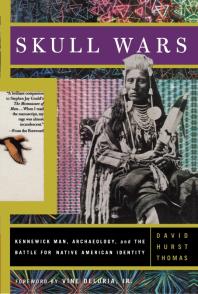

Alexandra (Alex) Wohnsen
Senior Research Librarian for Academic
Initiatives & Experiential Learning
awohnsen@hamilton.edu
315-859-4321
Make an appointment for research help
Native news sources are much less accessible than other published materials on Kennewick Man. Listed below are links to individual articles, separated by publication
Confederated Umatilla Journal: Each of these links will take you to an entire issue of the paper. Stories on the Ancient One begin on the front page and often continue on a jump page. The CUJ was started in the late 1970s. It was published sporadically through the mid-1980s, then abandoned for several years before it was restarted on a random basis. The paper began publishing monthly again in August of 1994. Its first full-time editor was hired in 1996.
Indian Country Today: Indian Country Today is a daily digital news platform that covers the Indigenous world, including American Indians and Alaska Natives. Indian Country Today is the largest news site that covers tribes and Native people throughout the Americas.
The Native American Times: formerly a weekly print publication based in Oklahoma, now an online publication. These two pieces, while published for a native audience are written by the Associated Press
Native News Online: Native News Online reaches out to all nations. Native News Online is a online American Indian publication that is published six days each week Mon-Sat. Native News Online is a privately held entity that has no direct business allegiances to any particular American Indian tribe, government, or religious organization.
 Skull Wars Kennewick Man, Archaeology, and the Battle for Native American Identity
by
David H. Thomas
Skull Wars Kennewick Man, Archaeology, and the Battle for Native American Identity
by
David H. Thomas
Consider the following questions when you evaluate a source for use in persuading your readers:
1. Who is the author?
a. What is her or his area of expertise?
b. Institutional or agency or organizational affiliation(s)? If so, what are the stated values and goals of those groups? How might they affect reader perceptions of this author’s work?
c. Where does s/he publish? Online? In journals? In magazines or newspapers? In books published by university presses, organizations, associations, or commercial publishing houses only? In publications produced by a single agency or institute?
Consider the following:
i. Commercial publishing houses like MacMillan, Time/Warner, or Knopf
ii. University presses, like the University of Washington Press
iii. Associations, societies, businesses, industries, services that publish their own periodicals, either for the public or for their own staff .
iv. Governments and non- and intergovernmental bodies, such as the U.S., the Brookings Institute, or the United Nations.
v. Web publishers, which may include anyone with access to a computer network.
d. How does the cited source “fit” into the body of this author’s work?
e. When was this written (is it current enough)? Why was it written (e.g., in response to a specific event)?
2. Are there other perspectives in the literature that disagree with this work? How might that affect your argument? Have you considered addressing/mediating counterclaims?
3. Will this source be treated as credible or persuasive by your readers?
a. Does the author come across as rational/logical or emotional?
b. Do the author’s intentions for the piece (e.g., to inform, explain, educate, advocate, persuade or dissuade, sell a product or service, or serve as a soapbox) align with how you are trying to use the source?
c. Is the way the author has mapped the issues (and intellectual terrain) similar in field and scope to the work you’re trying to do?
d. Does the author exhibit a particular bias? (e.g., commitment to a point of view, acknowledgement of bias, presentation of facts and arguments for only one side of a controversial issue?) Also, where on the continuum of views on this topic does the author fall, and how do you need to account for that when you incorporate the source?
e. Examine the references/bibliography: Does the information appear to be valid and well- researched? (i.e., reasonable assumptions and conclusions, arguments and conclusions supported by evidence, opposing points of view addressed, opinions not disguised as facts, cited sources authoritative?) P.S. these are the benchmarks for your work too!
4. What about the cited source’s argument?
a. Are questions raised but not answered?
b. Is it self-referential rather than based upon a public discourse?
c. Is the argument in the source you’re citing consistent with the point you’re trying to make, or are you exploiting the original source (cherry-picking)?
Hamilton College, 198 College Hill Road, Clinton, NY 13323 • 315-859-4735 • Copyright © 2024 The Trustees of Hamilton College. All rights reserved.